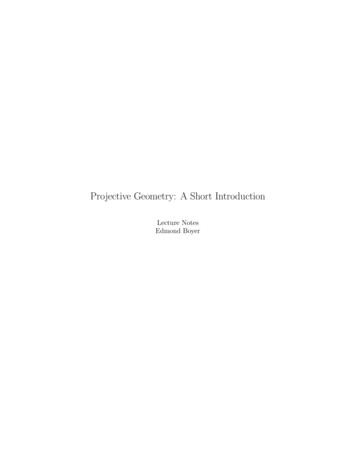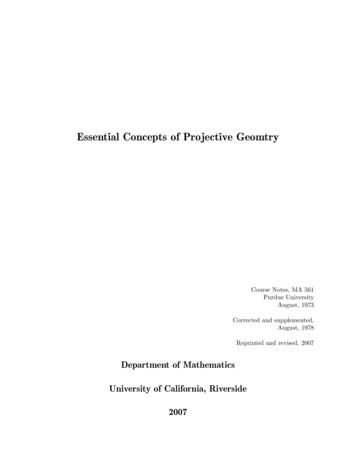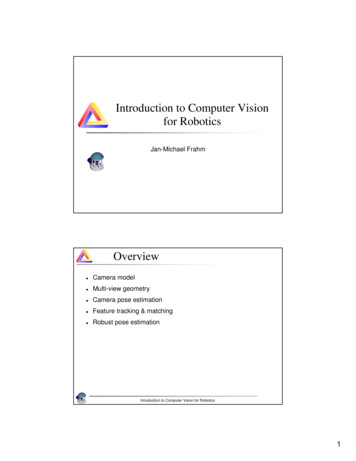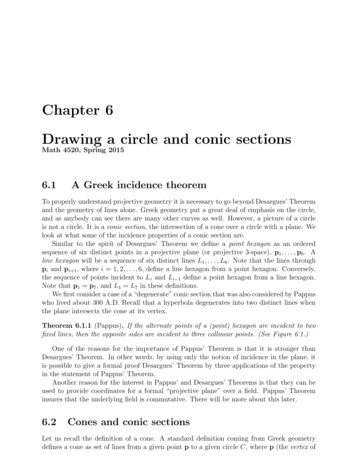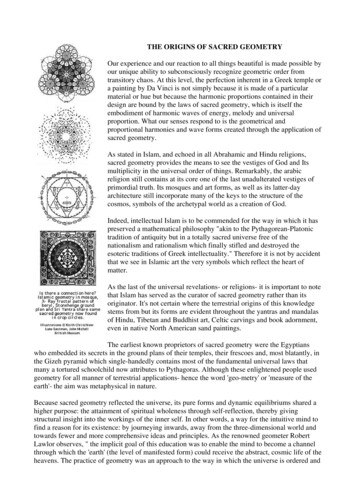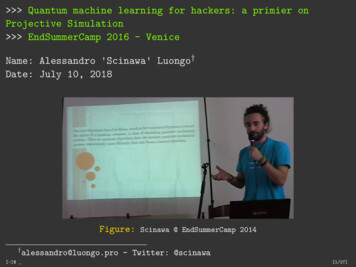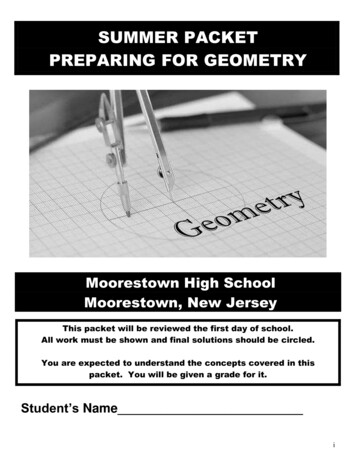
Transcription
PROJECTIVE GEOMETRYProjective geometry is a beautiful subject which has some remarkable applicationsbeyond those in standard textbooks. These were pointed to by Rudolf Steiner whosought an exact way of working scientifically with aspects of reality which cannot bedescribed in terms of ordinary physical measurements. His colleague George Adamsworked out much of this and pointed the way to some remarkable research done byLawrence Edwards in recent years. Steiner's spiritual research showed that there isanother kind of space in which more subtle aspects of reality such as life processestake place. Adams took his descriptions of how this space is experienced and founda way of specifying it geometrically, which is dealt with in the Counter Space Page.A brief introduction to the basics of the subject is given in the Basics Page.http://www.nct.anth.org.uk/ (1 of 2) [19/10/2011 15:18:45]
PROJECTIVE GEOMETRYSee also Britannica: projective geometryThe work of Lawrence Edwards is introduced in the Path Curves Page, and someexplorations of his work on further aspects is described in the Pivot Transforms Page.This is mostly pictorial, with reference to documentation.YOU ARE INVITED TO EXPLORE!Nick ThomasReferences and selected other sites are listed on the People page.Feedback welcome! Please include the word "counterspace" in the text and mail tonctsm At safe-mail.net, replacing At with @ of course.locations of recent changeshttp://www.nct.anth.org.uk/ (2 of 2) [19/10/2011 15:18:45]
BasicsProjective geometry is concerned with incidences, that is, where elements such aslines planes and points either coincide or not. The diagram illustrates DESARGUESTHEOREM, which says that if corresponding sides of two triangles meet in threepoints lying on a straight line, then corresponding vertices lie on three htm (1 of 8) [19/10/2011 15:18:47]
BasicsThe converse is true i.e. if corresponding vertices lie on concurrent lines thencorresponding sides meet in collinear points. This illustrates a fact about incidencesand has nothing to say about measurements. This is characteristic of pure projectivegeometry.It also illustrates the PRINCIPLE OF DUALITY, for there is a symmetry betweenthe statements about lines and points. If all the words 'point' and 'line' are exchangedin the statement about the sides, and then we replace 'side' with 'vertex', we get thedual statement about the vertices.The most fundamental fact is that there is one and only one line joining two distinctpoints in a plane, and dually two lines meet in one and only one point. But what, youmay ask, about parallel lines? Projective geometry regards them as meeting in anIDEAL POINT at infinity. There is just one ideal point associated with eachdirection in the plane, in which all parallel lines in such a direction meet. The sumtotal of all such ideal points form the IDEAL LINE AT INFINITY.The next figure shows the process of projection of a RANGE of points on a yellowline into another range on a distinct (blue) line. The set of (green) projecting lines inthe point of projection is called a PENCIL of lines. The points are indicated by thecentre points of white crosses.The two ranges are called PERSPECTIVE ranges. The process of intersection of apencil by a line to produce a range is called SECTION. Projection and section arehttp://www.nct.anth.org.uk/basics.htm (2 of 8) [19/10/2011 15:18:47]
Basicsdual processes. The above procedure may be repeated for a sequence of projectionsand sections. The first and last range are then referred to as PROJECTIVERANGES. If corresponding points of two projective ranges are joined the resultinglines do not form a pencil, but instead very beautifully envelope a CONIC SECTION,that is an ellipse, hyperbola or parabola. These are the shapes arising if a plane cuts acone, and in fact include a pair of straight lines and also, of course, the circle.Using the dual process a conic can be constructed by points using projective pencils.There are many theorems that there is no space to explain here. An example is givenon the home page showing Pascal's theorem, and illustrations of others are listedbelow.A particularly important subject for counter space is that of polarity, which is relatedto the principle of duality. If the tangents to a conic through a point are drawn, thehttp://www.nct.anth.org.uk/basics.htm (3 of 8) [19/10/2011 15:18:47]
Basicsline joining the two points of tangency is called the POLAR LINE of the point, anddually the point is called the POLE of that line. This is illustrated below.The fact to note here is that the polars of the points on a line form a pencil in a point,which is the polar of that line. The situation is self-dual.In three dimensions we illustrate the same principle but with a sphere and a point.The cone with its apex in that point, and which is tangential to the sphere, determinesa plane (red) containing the circle of contact. That plane is the POLAR PLANE ofthe point, and the point is the POLE of the plane.http://www.nct.anth.org.uk/basics.htm (4 of 8) [19/10/2011 15:18:47]
BasicsSimilarly to the two-dimensional case, if we take the polar planes of all the points ina plane, they all contain a common point which is the pole of that plane. Lines arenow self-polar.When counter space is studied this property of points and planes is used toconceptualise the idea of a negative space, as we reverse the roles of centre andinfinity.AFFINE & METRIC GEOMETRYInfinity is not invariant for projective geometry, in the sense that ideal points may betransformed by it into other points. In a plane the ideal points form an ideal line, andin space they form an ideal plane or plane at infinity. A special case of projectivehttp://www.nct.anth.org.uk/basics.htm (5 of 8) [19/10/2011 15:18:47]
Basicsgeometry can be defined which leaves the plane at infinity invariant (as a whole) i.e.ideal elements are never transformed into ones that are not at infinity. This is knownas affine geometry. A further special case is possible where the volume of objectsremains invariant, which is known as special affine geometry. Finally a furtherspecialisation ensures that lengths and angles are invariant, which is metric geometry,so called because measurements remain unaltered by its transformations.Other TheoremsCross Ratio. The cross ratio of four points is the only numerical invariant ofprojective geometry (if it can be related to Euclidean space). Flat line pencilsand axial pencils of planes containing a common line also have cross ratios.Quadrangle Theorem. If two quadrangles have 5 pairs of corresponding sidesmeeting in collinear points, the sixth pair meet on the same line. Proofindicated using Desargue's Theorem.Harmonic Range. Construction of two pairs of points harmonically separated,which have a cross ratio of -1.Homology. A basic projective transformation in which corresponding sidesmeet on a fixed line called the axis, and corresponding points lie on linesthrough the centre.Pappus' Theorem. This was one of the earliest discoveries, and can beregarded as a special case of Pascal's Theorem.Brianchon's Theorem. This is the dual of Pascal's Theorem although it wasdiscovered independently.Measures and TransformationsIt is best to view the first item before those later in the list. They show repeatedtransformations of the points on a line.http://www.nct.anth.org.uk/basics.htm (6 of 8) [19/10/2011 15:18:47]
BasicsBreathing (or hyperbolic) Measure. A point is shown moving along a linebetween two invariant points (with construction).Growth Measure with one invariant point at infinity. The ratios of thedistances of successive points from the other invariant point are constant.Step (or parabolic) Measure, in which the two invariant points coincide. Thisis how equal steps appear in counter space for our ordinary consciousness.Step Measure with both invariant points at infinity, which yields equal steps.The proof follows from the fact that triangles on the same base and between thesame parallels are equal in area.Circling (or elliptic) Measure in which there are no invariant points. The twoauxiliary lines used in the above constructions may be regarded as special casesof a conic.If you attempt to impose three invariant points on a line (e.g. in the first constructionby taking the first corresponding pair as coincident) you will find all points are selfcorresponding. This is the Fixed Point Theorem of projective geometry.The following animations show the application of the above to transformation of aplane, in these examples lines being transformed by means of two measures on twosides of the invariant triangle.Projective transformation in which it is demonstrated that parallelism is notconserved.Affine transformation where two red parallel lines are transformed into twoparallel lines (one green and one blue). This is affine because one side of theinvariant triangle is at infinity since each measure has an invariant point atinfinity.References 6 and 8 and 9 give a good introduction to projective geometry, where theabove facts are proved.http://www.nct.anth.org.uk/basics.htm (7 of 8) [19/10/2011 15:18:47]
Basicshttp://www.nct.anth.org.uk/basics.htm (8 of 8) [19/10/2011 15:18:47]
Path CurvesThe picture shows an egg form constructed mathematically. The spirals arecharacteristic of the mathematics and are known as PATH CURVES. They werediscovered by Felix Klein in the 19th Century, and are very simple and fundamentalmathematically speaking. Geometry studies transformations of space, and thesecurves arise as a result. A simple movement in a fixed direction such as drivingalong a straight road is an example, where the vehicle is being transformed by what iscalled a translation. In our mathematical imagination we can think of the whole ofspace being transformed in this way. Another example is rotation about an axis. Inboth cases there are lines or curves which are themselves unmoved (as a whole) byhttp://www.nct.anth.org.uk/path.htm (1 of 7) [19/10/2011 15:18:50]
Path Curvesthe transformation : in the second case circles concentric with the axis (round whichthe points of space are moving), and in the first case all straight lines parallel to thedirection of motion. These are simple examples of path curves. More complicatedtransformations give rise to more interesting curves.The transformations concerned are projective ones characteristic of projectivegeometry, which are linear because neither straight lines nor planes become curvedwhen moved by them, and incidences are preserved (this is a simplification, but willserve us here). They allow more freedom than simple rotations and translations, inparticular incorporating expansion and contraction. Apart from the path curves theyleave a tetrahedron invariant in the most general case. George Adams studied thesecurves as he thought they would provide a way of understanding how space andcounter space interact. A particular version he looked at was for a transformationwhich leaves invariant two parallel planes, the line at infinity where they meet, andan axis orthogonal to them. This is a plastic transformation rather than a rigid one(like rotation) and a typical path curve together with the invariant planes and axis isshown below.http://www.nct.anth.org.uk/path.htm (2 of 7) [19/10/2011 15:18:50]
Path CurvesThis will be recognised as the type of curve lying in the surface of the egg at the topof the page. If we take a circle concentric with the axis and all the path curves whichpass through it then we get that egg-shaped surface. The construction is shown in thefollowing animation:http://www.nct.anth.org.uk/path.htm (3 of 7) [19/10/2011 15:18:50]
Path CurvesWe can vary the transformation to get our eggs more or less sharp, or alternatively wecan get vortices such as the following:http://www.nct.anth.org.uk/path.htm (4 of 7) [19/10/2011 15:18:50]
Path CurvesIn these pictures particular path curves have been highlighted. This particular vortexis an example of a watery vortex, so called by Lawrence Edwards because its profilefits real water vortices. It is characterised by the fact that the lower invariant plane isat infinity. If instead the upper plane is at infinity we get what he calls an airy vortex.Two parameters are of particular significance: lambda and epsilon. Lambda controlsthe shape of the profile while epsilon determines the degree of spiralling. Lambda ispositive for eggs and negative for vortices, while the sign of epsilon controls thesense of rotation. This is illustrated below.The top row shows lambda increasing from 1 (elliptical) to 10. When lambdareaches infinity the form becomes conical. The centre row shows lambda increasingfrom -0.616 to -0.1 for a vortex. The bottom row shows epsilon varying from 0.2 tohttp://www.nct.anth.org.uk/path.htm (5 of 7) [19/10/2011 15:18:50]
Path Curves10, and when it reaches infinity the curves are vertical. If it is zero then the pathcurves become horizontal circles, and strictly speaking the profile is lost.The profile is thus controlled by a single parameter (lambda), and it is scientificallyinteresting that with such a restriction these curves fit very closely a wide variety ofnatural forms including eggs, flower and leaf buds, pine cones, the left ventricle ofthe human heart, the pineal gland, and the uterus during pregnancy. The wateryvortex closely fits actual stable water vortices. Together with the airy vortex it alsohas significance for pivot transforms. The following shows approximately the waythe left ventricle of the heart behaves as a path curve from diastole to systole:Lawrence Edwards spent many years finding out and testing the above factsexperimentally, which he has described in Reference 7. In 1982 he started testing theshapes of the leaf buds of trees through the winter, and found that their lambda value(unexpectedly) varied rhythmically with a period of approximately two weeks. Thiswas his main topic of research in his later years, and the evidence is now very strong backed by thousands of measurements - that the rhythm corresponds to theconjunctions and oppositions of the Moon and a particular planet for each tree. Thisis a purely experimental fact and care should be taken in interpreting it.Download document Practical Path Curve Calculations for basic algebra andformulae to work with path curves (Word 97 document).http://www.nct.anth.org.uk/path.htm (6 of 7) [19/10/2011 15:18:50]
Path Curveshttp://www.nct.anth.org.uk/path.htm (7 of 7) [19/10/2011 15:18:50]
COUNTERSPACEWhat is Counter Space?Counter space is the space in which subtle forces work, such asthose of life, which are not amenable to ordinary measurement.It is the polar opposite of Euclidean space. It was discovered byhttp://www.nct.anth.org.uk/counter.htm (1 of 5) [19/10/2011 15:18:53]
COUNTERSPACEthe observations of Rudolf Steiner and described geometricallyby George Adams and, independently, by Louis Locher-Ernst.Instead of having its ideal elements in a plane at infinity it hasthem in a "POINT at infinity". They are lines and planes, ratherthan lines and points as in ordinary space. We call this point thecounter space infinity, so that a plane incident with it is said tobe an ideal plane or plane at infinity in counter space. It onlyappears thus for a different kind of consciousness, namely aperipheral one which experiences such a point as an infiniteinwardness in contrast to our normal consciousness whichexperiences an infinite outwardness.Nick Thomas has explored the idea that objects existing in bothspaces at once are subject to strain and stress, and an analysis ofthese leads to new approaches to gravity and other forces assummarised in the diagram below. The pentagons are 'hotspots' to explore further.http://www.nct.anth.org.uk/counter.htm (2 of 5) [19/10/2011 15:18:53]
COUNTERSPACELINKAGESA linkage is an element that belongs to both Euclidean- and counter-space at oncee.g. a point or plane. Suppose a cube is linked to both spaces at once, and is movedupwards away from the inner infinitude. It will try to obey the metrics of bothspaces, and the diagram below shows what happens as it moves, the yellow versionobeying space and staying the same size and shape in space, while the magentaversion obeys the counter space metric.http://www.nct.anth.org.uk/counter.htm (3 of 5) [19/10/2011 15:18:53]
COUNTERSPACEThe counter space- or inner-infinity is shown as a point at the bottom, and lines havebeen drawn from it through the vertices of the cube. The counter-spatial movementis such that the vertices stay on these lines in order to obey its metric properties, asillustrated by the magenta cube, while the spatial one stays the same spatially. Withour ordinary consciousness that is what seems natural, of course, but for a counterspace consciousness the other is most natural and the yellow cube appears to begetting bigger (NOT smaller!!). The geometric difference between the two cubes isreferred to as strain, analogously to the use of that term in engineering where it is thepercentage deformation in size when, for example, an elastic band is stretched. Theelastic band responds to the strain by exerting a force, which is referred to as stress.The central thesis here is thus:1.Objects may be linked to both spaces at once,2. When they are, strain arises when they move as the metrics areconflicting,3.Stress arises as a result of the strain.http://www.nct.anth.org.uk/counter.htm (4 of 5) [19/10/2011 15:18:53]
COUNTERSPACENote well that stress is not a geometric concept, and we move from geometry tophysics when we consider stress. The major stress-free movement or transformationis rotation about an axis through the counter space infinity,. which may explain theubiquitous appearance and importance of rotation in most branches of physics e.g. influid flow.This, and all else in the pages concerned with counter space, is explained in moredetail in "Science Between Space and Counterspace" (Reference 11). Some algebraicdetails are given in the subordinate algebraic page.http://www.nct.anth.org.uk/counter.htm (5 of 5) [19/10/2011 15:18:53]
Pivot TransformsIf any plane is placed in a path curve transformation then it is being moved by thattransformation. There is generally one point in it which is momentarily stationary,that is, the plane is pivoting about that point. It is known as the pivot point of theplane. If we place a surface in the transformation then every one of its tangentplanes has such a pivot point, and they form another surface known as the pivottransform of the first one. They are described by Lawrence Edwards (Reference 7).The author has written a brief summary assuming college level mathematics. Theabove animation shows how the transform of a vortex varies as its lambda value isvaried from -0.9 to -0.1, other parameters being held constant.http://www.nct.anth.org.uk/pivot.htm (1 of 11) [19/10/2011 15:18:57]
Pivot TransformsLawrence Edwards discovered these transforms when investigating the shapes ofplant seed pods. He found that if a suitably positioned watery vortex is transformed itgives a very good fit. The following animation shows how such a transform may beconstructed:The initial picture shows part of the vortex, the lower invariant plane of the budtransformation as a horizontal line, and two centres of projection and an auxiliary linedetermined by the bud lambda and epsilon. The final profile is shown by black dotswhere corresponding blue tangents and red lines meet. The blue lines representtangent planes orthogonal to the picture, and the red ones horizontal planes.He then investigated how an airy vortex is transformed and found forms displayinginvagination, reminiscent of embryonic forms. He calculated the horizontal profileof the transform of a particular vortex, and as the the vortex axis was rotated the formchanged as shown below.http://www.nct.anth.org.uk/pivot.htm (2 of 11) [19/10/2011 15:18:57]
Pivot TransformsThe vortex axis starts at 19º to the vertical at an azimuth of 180º, swinging round to163º azimuth and 62º to the vertical (for the largest image).The full three-dimensional forms containing these profiles (which were 30 percent upfrom the bottom) are shown below:These images were obtained by calculating the angle of the tangent plane at eachvisible point, and setting the brightness according to its orientation to the direction ofillumination. This required a sophisticated bisection algorithm which could nothttp://www.nct.anth.org.uk/pivot.htm (3 of 11) [19/10/2011 15:18:57]
Pivot Transformsalways find the required root of the equation, which is why there are blemishes.The following image shows some other such forms where the vortex axis alwayscontains the upper invariant point of the bud transformation (hence the symmetry).Of course other surfaces can be transformed, and we see for example how bell formscan be obtained from quadric surfaceshttp://www.nct.anth.org.uk/pivot.htm (4 of 11) [19/10/2011 15:18:57]
Pivot TransformsPIVOT TRANSFORMS AS GYNOECIUM FORMSOn the Path Curves page the application of those curves is briefly described.Below are two examples of actual results:http://www.nct.anth.org.uk/pivot.htm (5 of 11) [19/10/2011 15:18:57]
Pivot TransformsThis shows a Kerria Japonica bud with the theoretical curve superimposed in red,which can be seen to be an excellent fit. It is accomplished by selecting the axis byeye together with several points on the profile, and then finding the best mean lambdato fit them. The mathematical curve approaches the top and bottom points (markedby crosses) asymptotically, and we cannot expect an actual physical form toaccomplsh that! So the top and bottom points are varied on the axis to minimise thedeviation. The top point is in this case above the physical bud, but more usually forother buds there is a physical prominence above the mathematical top. Thepercentage deviation of the lambda value is 1.2%, a very good result as that is a moresensitive indicator than the mean radius deviation. An added interest in this case washttp://www.nct.anth.org.uk/pivot.htm (6 of 11) [19/10/2011 15:18:57]
Pivot Transformsthat only the right profile was analysed, yet the resulting fit is also excellent for theleft profile. Many buds, like the rose below, are asymmetrical and with a prominenceat the top.Lawrence Edwards discovered the Pivot Transform when seeking a way to describethe gynoecium or seed pod. His idea was to use the projective transformation thatproduces the bud form to transform another surface. The path curves arise as theinvariant curves of a linear transformation, and that very transformation is then usedto transform another surface. He found that transforming a water vortex gave theform of the gynoecium (in contrast to the transformation of the airy vortex shownabove). The picture below shows a rose bud and its seed pod. As it is asymmetricalthe left profile of the bud was analysed, and the resulting fit is shown in red on thebud. Then the transformation corresponding to that was used to find a vortex thattransformed into the gynoecium, the result being superimposed on the left side of theseed pod. The closeness of the fit is striking. What is more striking is that thisprocess applies to many buds i.e. in every case it is a watery vortex that istransformed by the bud transformation to give the gynoecium. The vortex is coaxialwith the bud, and its invariant plane lies between those of the bud m (7 of 11) [19/10/2011 15:18:57]
Pivot TransformsClearly there is some kind of trade-off between the ideal form represented by themathematical curves and the physical necessities of actually producing it, togetherwith the required structural integrity which requires a stalk, and a portion between thegynoecium and the bud where the sepals were attached, and so on. The attempt to fita gynoecium form is very sensitive to the relation between the bud lambda and theactual gynoecium size, and will fail if the lambda is not determined accurately i.e. wedo not just get a bad fit, we get none at all as the mathematics fails with imaginaryvalues where we require real ones.The next picture shows the fit for another rose bud , illustrating that the gynoeciumreally does depend upon the bud shape and is not just a standard one, as the shape ismore elliptic than the above one:http://www.nct.anth.org.uk/pivot.htm (8 of 11) [19/10/2011 15:18:57]
Pivot TransformsIn this case there is a large prominence at the top which evidently is not part of thebud, and any attempt to include it with a bad fit fails to find any gynoecium form atall. It opens up the possibility for such buds of finding a criterion for judging whatbelongs to the ideal form in physical reality, and reinforces the judgement made byeye, which is easy in this case.Although the right hand profile is less precise, bearing the above remarks in mind it isnevertheless possible to find a good path curve for it, and a surprisingly goodgynoecium fit:http://www.nct.anth.org.uk/pivot.htm (9 of 11) [19/10/2011 15:18:57]
Pivot TransformsSuch results can only excite wonder at the processes occurring in Nature, and howmuch we have to learn about their holistic aspects which can be investigated with thisapproach.The prints shown above were obtained by placing the bud directly in an enlarger toobtain the profile, and the lines drawn on them were for hand calculation of theparameters. However the red curves were obtained by computer methods.The mathematics of the pivot transform is described in Reference 7 and also in thedocument Pivot Transforms.http://www.nct.anth.org.uk/pivot.htm (10 of 11) [19/10/2011 15:18:57]
Pivot Transformshttp://www.nct.anth.org.uk/pivot.htm (11 of 11) [19/10/2011 15:18:57]
PeopleRUDOLF STEINERRudolf Steiner RudolfSteiner was born in 1861 and lived until 1925. He developedspiritual science by applying the scientific method to his remarkable powers ofclairvoyant perception. When observing subtler aspects of existence he couldchange his consciousness so that instead of experiencing the world from a centralpoint of view his consciousness moved to the cosmic periphery. He described hisfindings in over 50 written works and nearly 6,000 lectures. He founded theAnthroposophical Society in 1912 and gave impulses for new more spiritualapproaches to agriculture (biodynamic), architecture, the arts, education, care of thehandicapped, medicine, science and social science, as well as the path of individualspiritual development. He was born in Kraljevic in Austria (now in Croatia), he readchemistry, natural science and mathematics for his degree and obtained his doctoratein philosophy.GEORGE ADAMShttp://www.nct.anth.org.uk/people.htm (1 of 6) [19/10/2011 15:18:59]
PeopleGeorge Adams von Kaufmann was born in 1894 andlived until 1963. He read chemistry at Cambridge andcame into contact with Steiner's work while a student.He was active as a pacifist in the First World War anddid social work with the Quakers, in particular with theFriends' War Relief organisation in Poland. He workedfor the rest of his life for Anthroposophy with a specialinterest in the scientific side as well as developing thesocial aspects. He interpreted Steiner's lectures inEngland and later translated many of them intoEnglish. He discovered how to describe Steiner'sfindings about negative space in geometric terms. Heworked particularly with projective geometry and theapplication of path curves.LAWRENCE EDWARDSLawrence Edwards (1912 -2003) studied the work ofRudolf Steiner and as a result he became a ClassTeacher as well as an upper school mathematicsteacher at the Edinburgh Rudolf Steiner School untilhe retired. He was inspired to carry out scientificresearch after studying projective geometry withGeorge Adams, following a "moonlighting" secondcareer testing whether the path curves he had learntabout applied to real forms in Nature. This heconfirmed for the forms of many flower and leaf budsas well as for the human heart. He found importantrhythmic processes active in leaf bud forms over the winter months which correlatehttp://www.nct.anth.org.uk/people.htm (2 of 6) [19/10/2011 15:18:59]
Peoplewith planetary rhythms. He was a friend, inspirer and helper to many others.NICK THOMASNick Thomas was born in 1941, educated as anelectrical engineer, and became an engineering officerin the RAF for 16 years. He met the work of RudolfSteiner at the age of 18 and has been inspired by itever since. In particular he seeks to reconcile Steiner'sspiritual research with the findings of science, and hasfound projective geometry to be a beautiful andappropriate approach. Lawrence Edwards befriendedhim early on and helped him greatly. Some of hisinterests and work are outlined in these pages.References1. The Philosophy of Spiritual Activity, Rudolf Steiner, Rudolf Steiner Press, London1979.http://www.nct.anth.org.uk/people.htm (3 of 6) [19/10/2011 15:18:59]
People2. Space and the Light of Creation, George Adams Kaufmann, Published by theAuthor, London 1933.3. Universal Forces in Mechanics, George Adams, Rudolf Steiner Press, London1977.4. The Lemniscatory Ruled Surface in Space and Counterspace, George Adams,Rudolf Steiner Press, London 1979.5. The Plant Between Sun and Earth, Adams and Whicher, Rudolf Steiner Press,London 1980.6. Projective Geometry by Lawrence Edwards, Rudolf Steiner Institute, Phoenixville1985.7. The Vortex of Life, Lawrence Edwards, Floris Press, Edinburgh 1993.8. Projective Geometry,Veblen and Young, Ginn & Co., Boston 1910 (a classic).9. Projective Geometry, Dirk J. Struik, Addison-Wesley Publishing Co., London1953.10. Geometry, H.S.M. Coxeter, John Wiley & Sons, New York, 1969.11. Science Between Space and Counterspace, N.C. Thomas, Temple LodgePublishing, first publi
PROJECTIVE GEOMETRY Projective geometry is a beautiful subject which has some remarkable applications beyond those in standard textbooks. These were pointed to by Rudolf Steiner who sought an exact way of working scientifically with aspects of reality which cannot be described in terms of ordinary physical measurements. His colleague George Adams
